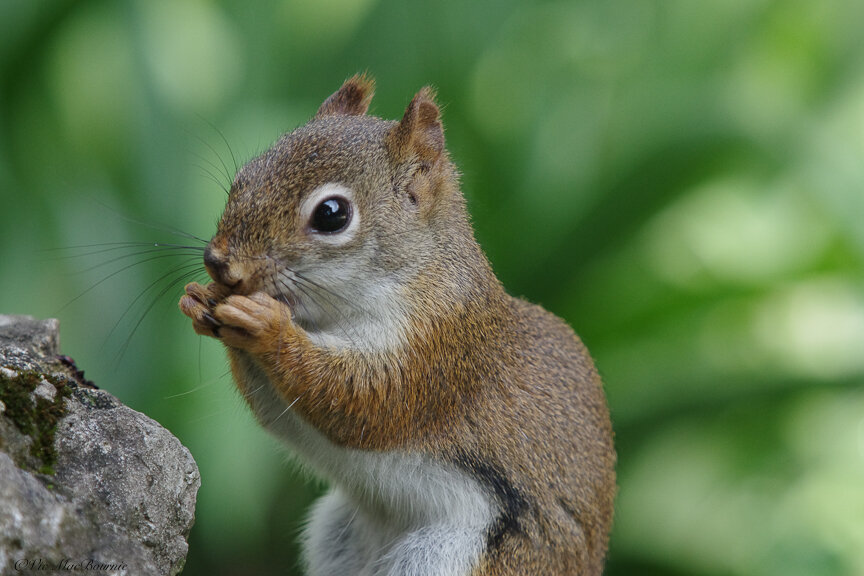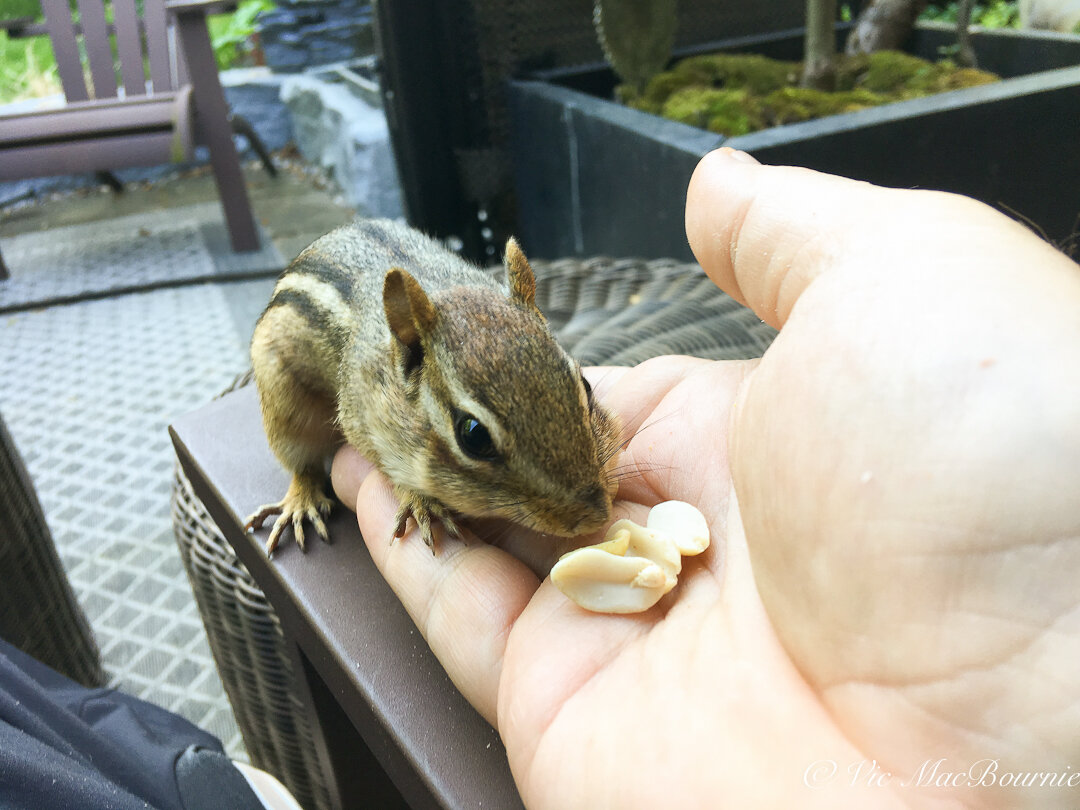Hand feeding chipmunks in five easy steps
Hand feeding chipmunks in your wildlife woodland garden is not difficult. All it takes is some patience and a good supply of peanuts. Then, it’s just a matter of befriending the Chipmunks to trust you enough to take the nuts out of your hand.
You’ll have them eating out of your hand in no time
Getting friendly chipmunks to feed out of your hand is not difficult providing you have patience and follow these five simple steps.
So how do we hand feed chipmunks?
The goal is to encourage the chipmunks to first become comfortable with your presence and then to slowly begin providing it with its favourite food in a way that it knows you are the provider. Don’t just leave it around, try to do it in the presence of the chipmunk. As it recognizes that you are friendly, move the food in closer to you. In a short period of time you should be able to encourage the chipmunk to come right beside you to collect its food. Then, it’s just a matter of getting it to take the food from your fingers. As time goes on, you should be able to encourage the little guys to crawl up on your open palm and collect its favourite food.
It can be helpful if you single out one or two particularly bold chipmunks who does not show much fear around you.
A couple of summers ago, I had a chipmunk, appropriately named Stubby because he sported half a tail, who I had feeding out of my hand in just one morning. In fact, Stubby became so friendly that before long he was taking peanuts from my mouth (well actually my lips). I’ll tell you it’s quite the interesting feeling to have the critters’ little hands on your bare leg, arm or chin while it is getting its food from you.
Needless to say, we became good friends over the summer. She lived the good life all summer with a nice stash of shelled peanuts, and my dog Holly and I enjoyed her friendship most days during my morning coffee.
Two behaviours to take note of: The first is foot stomping. It was not uncommon for Stubby, especially the first time we met each morning, for her to foot stomp while tail-thrashing. This is indicative of facing down an enemy. But I wasn’t the enemy and I think she knew it. I’m betting it was more a warning not to mess with her. I simply ignored it and had a little a chuckle even when she did her little dance on my bare leg.
The second is to not be surprised if the little guys acidently give you a little nip. Be prepared and try not to over react if you feel its teeth on your finger. Treat it like you would when you are training a dog to take treats from your hand. A stern “eh eh” will give it a signal not to do that. Stubby would sometimes mistake the tip of my finger or thumb for a peanut when I put the food in the palm of my hand. She would put her front teeth on my finger but quickly realize that it was not a peanut. She never actually bit me, but if you are uncomfortable with that, hold the peanut in such a way that the chipmunk takes it from your fingers with its front paws rather than the palm of your hand.
Stubby taking peanuts from my hand. They are actually very gentle little critters.
Nine Cool Facts about Chipmunks
• Chipmunks are the smallest members of the squirrel family.
• A single chipmunk can gather up to 165 acorns in a single day.
• They live primarily in burrows in an underground tunnel system that can be 10 to 30 feet (3 to 9.1 m) long.
• Although chipmunks do hibernate, they don’t store fat so they become active during warm periods over the winter. They also stuff extra food in their cheek pouches to take it to an underground food cache where they use it as a food source during hibernation.
• Chipmunks can stretch their cheek pouches three times larger than their heads.
• They are not particularly social animals and only interact during the spring mating season.
• There are 25 species of chipmunk, The Siberian chipmunk that is found in Asia and parts of Europe is the only one that lives outside of North America
• The Eastern chipmunk is the largest of the species and can grow to 11 inches (28 centimeters) and weigh in at up to 4.4 ounces or 125 grams.
•Chipmunk tails can grow from 3 to 5 inches
A close approach is not difficult once you gain their confidence.
Detailed approach to hand-feeding Chipmunks
Okay, let’s get a little more detailed about the five steps to encourage Chipmunks to feed out of your hand.
1) The first step is to simply find a comfortable chair near where you have seen chipmunks on a regular basis. If your woodland wildlife garden is mature, there is a good chance you can pick a site almost anywhere in the garden. Near a bird feeder is usually a good place to start. It’s likely the chipmunks are already making regular visits to the bird feeding location and are comfortable with you being around on a regular basis
Preferably this “comfortable chair” is located in an area where you sit regularly anyway. If you like to have your morning coffee on the patio, that’s the place to focus on to begin your hand feeding project.
2) Now every time you go to your favourite chair with your morning coffee, make sure you come armed with your food of choice. I like to store the peanuts in a convenient but safe spot, either in a steel can, glass jar or locked away in a nearby shed or deck box. Chipmunks seem to like shelled peanuts, but unshelled peanuts are just as good. Sunflowers will work well here too. The shelled peanuts are so large that chipmunks can usually only fit a couple in their cheek pockets before running off to their storage cache.
Before long, they’re back again looking for more. Chipmunks can fit a lot of unshelled peanuts and sunflower seeds into their cheek pockets so be prepared with a good stash nearby.
3) The other good reason to load up on shelled peanuts is the ease in which you can toss them in the direction of the chipmunk. I like to flick them by placing the peanut between my thumb and index finger and then, when I see the chipmunk, even if it is far away, I can flick the peanut over toward it. By doing it this way there is no large, sudden arm movements to scare the chipmunk away. Although a peanut flying through the air might scare the chipmunk the first couple times, before long it is scampering to retrieve them.
4) Now that the chipmunks know who their friend is, you can begin placing the peanuts in small piles near you. As the chipmunk becomes more and more accustomed to your presence, move the food in closer until they are right beside you. As they approach, hold as still as possible to give them the confidence to continue. I like to talk to them quietly to get them accustomed to my voice. Getting to this stage does not usually take too long providing your chipmunks are not too skittish.
Friendly red squirrel who shared an afternoon with me and ended up jumping on my shoulder.
5) Getting them to feed out of your hand is a little trickier. If you are sitting in a chair, you have to figure out a way to get them up on the chair. Chipmunks can usually make their way up most chairs, but I encouraged my little chipmunk to crawl up my leg by strategically placing peanuts along my leg until it finally reached the armchair. From there, feeding it out of my hand was simple. Remember though, any sudden movements will send it scampering away and too many quick movements might make the chipmunk too skittish to return.
Remember, move slow, speak softly and have plenty of peanuts ready.
I follow the same procedure for red squirrels but don’t encourage them to run up my leg. I just give them peanuts from a short distance. I did, however, have one decide to jump on my head during a photo shoot a couple of years ago.
I was placing peanuts on a boulder and photographing a friendly red squirrel who was happy to pose for me for the price of a couple of peanuts. At one point “Big Red” got behind me. I could hear him in the garden behind me and in a tree just above where I was sitting. I decided to ignore him rather than turn around and possibly scare the friendly little guy.
Before I knew it, he climbed up the back of the chair and jumped on my shoulder. Hmmmmm that was weird. I managed not to over react and stay calm. He looked around from his high vantage point on my shoulder for a few seconds before jumping down and continuing the photo shoot.
Fun times.
It’s a great feeling to have a little chipmunk’s claws on your bare skin as they gently take the peanut out of your hand.
Are chipmunks dangerous?
Chipmunks are not dangerous, but that does not mean a particular chipmunk can’t be a problem. Like other rodents, they can be carriers of disease and any animal that is fed by us humans can lose their fear of people and become dangerous.
I do not recommend feeding carnivores such as coyotes, foxes and certainly not wildcats or other larger carnivores.
Chipmunks are also mischievous little critters that can result in them getting into trouble if they manage to get into your attic or if you try to treat them too much like a pet. Like most rodents, their teeth are constantly growing so a rubberized wire is fair game in their books. If they get into a shed, especially one with bird food, they may never leave.
And, like any wild animal, if they are cornered or fear their babies are threatened, they may get aggressive.
That being said, I have no fear of chipmunks and have handled them on more than a few occasions. Three rescues: one involving a neighbourhood cat, another involving our dog’s swimming pool, and the third requiring the removal of a yogurt bottle from a chipmunk’s head all involved handling a stressed chipmunk without gloves. Never have they been aggressive toward me in any way. For more on the rescues go to my article here.







